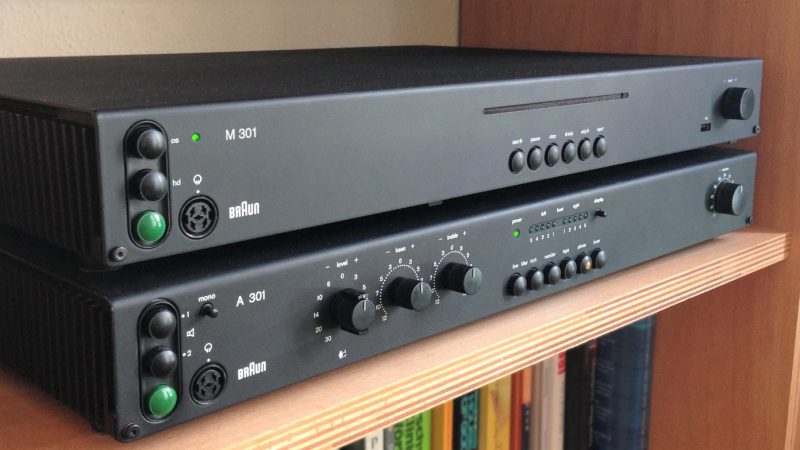Slotting a modern media center into an old stereo usually means adding Bluetooth and a Raspberry Pi to an amp or receiver, and maybe adding a few discrete connectors on the back panel. But this media center for a late-70s Braun hi-fi (translated) goes many steps beyond that — it fabricates a component that never existed.
The article is in German, and the Google translation is a little spotty, but it’s pretty clear what [Sebastian Schwarzmeier] is going for here. The Braun Studio Line of audio components was pretty sleek, and to avoid disturbing the lines of his stack, he decided to create a completely new component and dub it the “M301.”
The gutted chassis of an existing but defunct A301 amplifier became the new home for a Mac Mini, Blu-Ray drive, and external hard drive. An HDMI port added to the back panel blends in with the original connectors seamlessly. But the breathtaking bit is a custom replacement hood that looks like what the Braun designers would have come up with if “media center” had been a term in the 70s.
From the brushed aluminum finish, to the controls, to the logo and lettering, everything about the component that never was shows an attention to detail that really impresses. But if you prefer racks of servers to racks of audio gear, this media center built into a server chassis is sure to please too.
Thanks to [Sascho] and [NoApple4Me] for the nearly simultaneous tips on this one.
















At first, I was like “Where’s the add on?” Didn’t even realize one of the units wasn’t stock.
Then I thought… Dang, that’s 1970s!? Where’s the faux wood grain? The giant chrome knobs? That thing looks sexy enough for ANY time period! Props to Braun for a TIMELESS design!
That’s Dieter Rams design for you :)
It’s from the LATE 70’s so faux wood and orange wallpaper were already very old fashioned. Sleek and minimal were all the rage after the Great Punk Wars.
You can tell it is dated by the green LEDs. Anything >2000 has blue LEDs.
Thats even sexier than my NAD system.
very nicely done
“But if you prefer racks of servers to racks of audio gear, this media center built into a server chassis is sure to please too.”
Aside from the noise, some servers can look pretty good. Not as nice as a Braun, but that’s a pretty high bar to jump.
That is some nice craftsmanship. I am really tired of seeing the laser cut plywood cases with scorch marks all over them.
Ditto on the scorched wood. WTF are people thinking? Just get a decent scroll saw.
Scroll saws require a certain degree of skill to use. Besides which, didn’t you know scorch marks are the new Orange?
Personally, I think they look rather amateurish…
IKWYM, they look really amateurish and kludgy, like somebody made it with a big iron poker, rather than state of the art computer-guided laser optics. Can you sandpaper away the burn marks without disfiguring the tabs too much?
Would a higher powered laser help? To be able to ablate away the wood it’s cutting, without the surrounding wood having time to heat up? Or perhaps different timing?
Impressive work. One reason I re-purpose old cases and enclosures is I like the “professional” look. I still have an old Pioneer receiver just looking for such a conversion.
Maybe an article on the principles involved in a professional look?
Google Translate breaks the navigation links in the top corner. So mouse over “Design performance engineering development” and click on Leistung for a feature description, Technik for specs/software used, and Entwicklung for the build notes.
Note, they used a mac mini as the replacement brains.
So much blackface electronics in the 70s. Don’t tell my silverface gear….
70s? I don’t buy it!
Perhaps these units he were matching were indeed from the 70s. That doesn’t mean that their style is anything typical of the 70s though. Silver face, wood grain rest, big knobs, big feet, big Vu meters and a couple ‘new fangled’ red or maybe even green LEDs…. now that’s 70s! If these chassis were produced in the 70s that doesn’t make that style 70s that just makes them ahead of their time.
At first glance.. without any text I would think it were early 90s… just before consumers completely finished losing their minds and even the high end stuff succumbed to the cheap throw-away non-modular plastic crap that makes Wally Mart so rich.
As CB4 pointed out above, that’s a Dieter Rams design. Subdued colors, uncluttered, ‘clean’ lines, etc.
Almost everything which has come out of Japan since has been based off of his work with more ‘traditional’ colour schemes, ie. Black/Gold/Silver etc.
What’s with the headphone jack? I thought quarter inch and eighth inch were as standard as it gets. A DIN headphone jack, OK but it will not work on phones or other low profile apps. You need to do that R2D2 gyrations to to plug it in.
From this pic it appears the Braun KH500 came with an adapter for these cans. http://www.radiomuseum.org/images/radio/braun_frankfurt/hifi_stereo_kopfhorer_kh_500_1265889.jpg
They used DINs for the speaker connections as well. European companies like Bang and Olufsen are notorious for using proprietary connectors for simple shit.
Apart from the fact that DIN connectors aren’t and weren’t proprietary. It kinda goes with the “DIN”-name. DIN basically means german institute for standardization.
I found a pair of headphones made by Videoton in our attic with the matching connector for this.